[English] 日本語
 Yorodumi
Yorodumi- PDB-4ith: Crystal structure of RIP1 kinase in complex with necrostatin-1 analog -
+ Open data
Open data
- Basic information
Basic information
| Entry | Database: PDB / ID: 4ith | ||||||
|---|---|---|---|---|---|---|---|
| Title | Crystal structure of RIP1 kinase in complex with necrostatin-1 analog | ||||||
 Components Components | Receptor-interacting serine/threonine-protein kinase 1 | ||||||
 Keywords Keywords | TRANSFERASE/TRANSFERASE INHIBITOR / alpha/beta / RIP1 kinase / necroptosis / necrostatins / KINASE / TRANSFERASE-TRANSFERASE INHIBITOR complex | ||||||
| Function / homology |  Function and homology information Function and homology informationripoptosome assembly / positive regulation of miRNA processing / positive regulation of interleukin-6-mediated signaling pathway / ripoptosome assembly involved in necroptotic process / death domain binding / peptidyl-serine autophosphorylation / ripoptosome / Defective RIPK1-mediated regulated necrosis / Microbial modulation of RIPK1-mediated regulated necrosis / TRIF-mediated programmed cell death ...ripoptosome assembly / positive regulation of miRNA processing / positive regulation of interleukin-6-mediated signaling pathway / ripoptosome assembly involved in necroptotic process / death domain binding / peptidyl-serine autophosphorylation / ripoptosome / Defective RIPK1-mediated regulated necrosis / Microbial modulation of RIPK1-mediated regulated necrosis / TRIF-mediated programmed cell death / Regulation by c-FLIP / CASP8 activity is inhibited / Dimerization of procaspase-8 / TLR3-mediated TICAM1-dependent programmed cell death / TNF signaling / programmed necrotic cell death / Caspase activation via Death Receptors in the presence of ligand / SARS-CoV-1-mediated effects on programmed cell death / positive regulation of macrophage differentiation / JUN kinase kinase kinase activity / T cell apoptotic process / necroptotic signaling pathway / NF-kB activation through FADD/RIP-1 pathway mediated by caspase-8 and -10 / death-inducing signaling complex / RIP-mediated NFkB activation via ZBP1 / positive regulation of necroptotic process / negative regulation of necroptotic process / positive regulation of tumor necrosis factor-mediated signaling pathway / death receptor binding / positive regulation of programmed cell death / positive regulation of programmed necrotic cell death / positive regulation of extrinsic apoptotic signaling pathway / TNFR1-induced proapoptotic signaling / RIPK1-mediated regulated necrosis / TRP channels / necroptotic process / response to tumor necrosis factor / positive regulation of execution phase of apoptosis / canonical NF-kappaB signal transduction / negative regulation of extrinsic apoptotic signaling pathway in absence of ligand / extrinsic apoptotic signaling pathway / signaling adaptor activity / negative regulation of canonical NF-kappaB signal transduction / TICAM1, RIP1-mediated IKK complex recruitment / IKK complex recruitment mediated by RIP1 / tumor necrosis factor-mediated signaling pathway / TNFR1-induced NF-kappa-B signaling pathway / positive regulation of interleukin-8 production / negative regulation of extrinsic apoptotic signaling pathway / positive regulation of JNK cascade / Regulation of TNFR1 signaling / protein catabolic process / positive regulation of non-canonical NF-kappaB signal transduction / positive regulation of NF-kappaB transcription factor activity / cellular response to growth factor stimulus / Regulation of necroptotic cell death / cellular response to hydrogen peroxide / positive regulation of protein phosphorylation / positive regulation of reactive oxygen species metabolic process / positive regulation of inflammatory response / positive regulation of tumor necrosis factor production / cellular response to tumor necrosis factor / Ovarian tumor domain proteases / positive regulation of neuron apoptotic process / protein autophosphorylation / response to oxidative stress / amyloid fibril formation / Potential therapeutics for SARS / positive regulation of canonical NF-kappaB signal transduction / non-specific serine/threonine protein kinase / receptor complex / protein kinase activity / endosome membrane / Ub-specific processing proteases / intracellular signal transduction / positive regulation of apoptotic process / inflammatory response / protein serine kinase activity / protein serine/threonine kinase activity / apoptotic process / ubiquitin protein ligase binding / positive regulation of gene expression / negative regulation of apoptotic process / protein-containing complex binding / protein homodimerization activity / positive regulation of transcription by RNA polymerase II / protein-containing complex / mitochondrion / ATP binding / identical protein binding / plasma membrane / cytoplasm / cytosol Similarity search - Function | ||||||
| Biological species |  Homo sapiens (human) Homo sapiens (human) | ||||||
| Method |  X-RAY DIFFRACTION / X-RAY DIFFRACTION /  SYNCHROTRON / SYNCHROTRON /  MOLECULAR REPLACEMENT / Resolution: 2.25 Å MOLECULAR REPLACEMENT / Resolution: 2.25 Å | ||||||
 Authors Authors | Xie, T. / Peng, W. / Liu, Y. / Yan, C. / Shi, Y. | ||||||
 Citation Citation |  Journal: Structure / Year: 2013 Journal: Structure / Year: 2013Title: Structural Basis of RIP1 Inhibition by Necrostatins. Authors: Xie, T. / Peng, W. / Liu, Y. / Yan, C. / Maki, J. / Degterev, A. / Yuan, J. / Shi, Y. | ||||||
| History |
|
- Structure visualization
Structure visualization
| Structure viewer | Molecule:  Molmil Molmil Jmol/JSmol Jmol/JSmol |
|---|
- Downloads & links
Downloads & links
- Download
Download
| PDBx/mmCIF format |  4ith.cif.gz 4ith.cif.gz | 221.8 KB | Display |  PDBx/mmCIF format PDBx/mmCIF format |
|---|---|---|---|---|
| PDB format |  pdb4ith.ent.gz pdb4ith.ent.gz | 178.6 KB | Display |  PDB format PDB format |
| PDBx/mmJSON format |  4ith.json.gz 4ith.json.gz | Tree view |  PDBx/mmJSON format PDBx/mmJSON format | |
| Others |  Other downloads Other downloads |
-Validation report
| Summary document |  4ith_validation.pdf.gz 4ith_validation.pdf.gz | 1.1 MB | Display |  wwPDB validaton report wwPDB validaton report |
|---|---|---|---|---|
| Full document |  4ith_full_validation.pdf.gz 4ith_full_validation.pdf.gz | 1.1 MB | Display | |
| Data in XML |  4ith_validation.xml.gz 4ith_validation.xml.gz | 23 KB | Display | |
| Data in CIF |  4ith_validation.cif.gz 4ith_validation.cif.gz | 31.2 KB | Display | |
| Arichive directory |  https://data.pdbj.org/pub/pdb/validation_reports/it/4ith https://data.pdbj.org/pub/pdb/validation_reports/it/4ith ftp://data.pdbj.org/pub/pdb/validation_reports/it/4ith ftp://data.pdbj.org/pub/pdb/validation_reports/it/4ith | HTTPS FTP |
-Related structure data
| Related structure data |  4itiC  4itjC 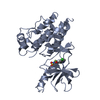 3c4cS C: citing same article ( S: Starting model for refinement |
|---|---|
| Similar structure data |
- Links
Links
- Assembly
Assembly
| Deposited unit | 
| ||||||||
|---|---|---|---|---|---|---|---|---|---|
| 1 | 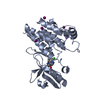
| ||||||||
| 2 | 
| ||||||||
| Unit cell |
|
- Components
Components
| #1: Protein | Mass: 33468.730 Da / Num. of mol.: 2 / Mutation: C34A, C127A, C233A, C240A Source method: isolated from a genetically manipulated source Source: (gene. exp.)  Homo sapiens (human) / Gene: RIPK1, RIP, RIP1 / Production host: Homo sapiens (human) / Gene: RIPK1, RIP, RIP1 / Production host:  References: UniProt: Q13546, non-specific serine/threonine protein kinase #2: Chemical | ChemComp-IOD / #3: Chemical | #4: Chemical | #5: Water | ChemComp-HOH / | |
|---|
-Experimental details
-Experiment
| Experiment | Method:  X-RAY DIFFRACTION / Number of used crystals: 1 X-RAY DIFFRACTION / Number of used crystals: 1 |
|---|
- Sample preparation
Sample preparation
| Crystal | Density Matthews: 2.13 Å3/Da / Density % sol: 42.16 % |
|---|---|
| Crystal grow | Temperature: 291 K / Method: vapor diffusion, hanging drop / pH: 5 Details: 0.25 M NH4I, 20% polyethylene glycol (PEG) 3350, 0.03 M glycyl-glycyl-glycine, pH 5.0, VAPOR DIFFUSION, HANGING DROP, temperature 291K |
-Data collection
| Diffraction | Mean temperature: 100 K |
|---|---|
| Diffraction source | Source:  SYNCHROTRON / Site: SYNCHROTRON / Site:  SSRF SSRF  / Beamline: BL17U / Wavelength: 1 Å / Beamline: BL17U / Wavelength: 1 Å |
| Detector | Type: ADSC QUANTUM 315r / Detector: CCD / Date: Jan 11, 2012 |
| Radiation | Monochromator: Si 111 CHANNEL / Protocol: SINGLE WAVELENGTH / Monochromatic (M) / Laue (L): M / Scattering type: x-ray |
| Radiation wavelength | Wavelength: 1 Å / Relative weight: 1 |
| Reflection | Resolution: 2.25→40 Å / Num. all: 27731 / Num. obs: 27706 / % possible obs: 99.3 % / Observed criterion σ(F): 1 / Observed criterion σ(I): 1 |
| Reflection shell | Resolution: 2.25→2.33 Å / % possible all: 98.7 |
- Processing
Processing
| Software |
| |||||||||||||||||||||||||||||||||||||||||||||||||||||||||||||||||||||||||||||||||||||||||||||||||||||||||||||||||||||||||||||
|---|---|---|---|---|---|---|---|---|---|---|---|---|---|---|---|---|---|---|---|---|---|---|---|---|---|---|---|---|---|---|---|---|---|---|---|---|---|---|---|---|---|---|---|---|---|---|---|---|---|---|---|---|---|---|---|---|---|---|---|---|---|---|---|---|---|---|---|---|---|---|---|---|---|---|---|---|---|---|---|---|---|---|---|---|---|---|---|---|---|---|---|---|---|---|---|---|---|---|---|---|---|---|---|---|---|---|---|---|---|---|---|---|---|---|---|---|---|---|---|---|---|---|---|---|---|---|
| Refinement | Method to determine structure:  MOLECULAR REPLACEMENT MOLECULAR REPLACEMENTStarting model: PDB entry 3C4C Resolution: 2.25→37.888 Å / SU ML: 0.34 / σ(F): 0 / Phase error: 26.17 / Stereochemistry target values: ML
| |||||||||||||||||||||||||||||||||||||||||||||||||||||||||||||||||||||||||||||||||||||||||||||||||||||||||||||||||||||||||||||
| Solvent computation | Shrinkage radii: 1.11 Å / VDW probe radii: 1.3 Å / Solvent model: FLAT BULK SOLVENT MODEL / Bsol: 39.716 Å2 / ksol: 0.322 e/Å3 | |||||||||||||||||||||||||||||||||||||||||||||||||||||||||||||||||||||||||||||||||||||||||||||||||||||||||||||||||||||||||||||
| Displacement parameters |
| |||||||||||||||||||||||||||||||||||||||||||||||||||||||||||||||||||||||||||||||||||||||||||||||||||||||||||||||||||||||||||||
| Refinement step | Cycle: LAST / Resolution: 2.25→37.888 Å
| |||||||||||||||||||||||||||||||||||||||||||||||||||||||||||||||||||||||||||||||||||||||||||||||||||||||||||||||||||||||||||||
| Refine LS restraints |
| |||||||||||||||||||||||||||||||||||||||||||||||||||||||||||||||||||||||||||||||||||||||||||||||||||||||||||||||||||||||||||||
| LS refinement shell |
| |||||||||||||||||||||||||||||||||||||||||||||||||||||||||||||||||||||||||||||||||||||||||||||||||||||||||||||||||||||||||||||
| Refinement TLS params. | Method: refined / Refine-ID: X-RAY DIFFRACTION
| |||||||||||||||||||||||||||||||||||||||||||||||||||||||||||||||||||||||||||||||||||||||||||||||||||||||||||||||||||||||||||||
| Refinement TLS group |
|
 Movie
Movie Controller
Controller


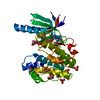
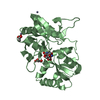

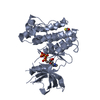
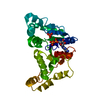

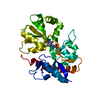
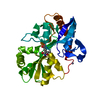


 PDBj
PDBj















